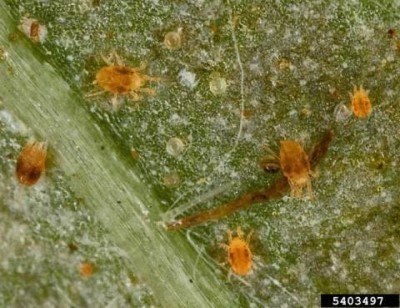 TSM adults and eggs. Image: Bugwood.org.
TSM adults and eggs. Image: Bugwood.org.
- We are getting reports to two spotted spider mite activity in Southern Illinois.
- Two spotted spider mites can become problematic in field crops under prolonged hot, dry conditions
- Two spotted spider mites are edge pests that often move into fields from preferred hosts such as alfalfa
- Scouting field edges during hot dry periods is recommended for high-risk fields
- If thresholds have been reached, there are several chemical interventions that can be applied.
Biology and Damage
The prolonged hot and dry weather throughout the Midwest has increased the risk of damage by Two-spotted spider mites (TSM) in soybean. This arachnid feeds on several plant genera and typically spills over from its preferred hosts into soybean fields. The pest is very small (<0.002 “) with eight legs, is yellow/dull orange color, and has two dark spots on its abdomen. TSM are most frequently observed moving on the underside of foliage, in addition to producing a cottony webbing.
TSM overwinter as eggs and develop through three stages from egg to adult. Development time varies depending on temperature, with development increasing as temperatures increase over 90°F. After mating, females can deposit close to 100 eggs, resulting in explosive population development in a short period of time. TSM pierce the plant epidermis and feed on the cell contents. Injury is an off green or yellow stippling and puckering of leaves that starts lower in the canopy and moves upwards over time, giving the plant a sandblasted appearance. Severely damaged leaves senesce and fall from the plant.
TSM are not typically an issue in field crops, as populations are often held in check by natural enemies such as fungal parasites and predatory mites. When long periods of drought are encountered, humidity is insufficient and temperatures too high for the fungal pathogens to grow and control the pest. In addition, heat increases the movement of spider mites from preferred food sources such as alfalfa and speeds up spider mite reproduction and development. This means that natural enemies cannot effectively keep populations in check.
Scouting and Management
TSM will be first encountered on field edges, most often when adjacent to weedy areas, ditches, and alfalfa fields that have been recently mowed or harvested. Look for areas of the field edge where plants are defoliating or have stippled leaves. Pull suspect plants and tap leaves over a white sheet of paper. Mites can move fast, so pay attention. The underside of leaves can also be assessed with the aid of a hand lens for the presence of mites and webbing.
If mites are present, determine how far up the canopy they have progressed. If you have consistently identified TSMs from suspect plants, additional portions of the field should be assessed. Scout the field by starting at the field edge and walk 100-150 ft into the field following a “U” pattern, stopping to assess 2-3 plants at 20 sites. Rate the average of the 3 plants you assess at each site for foliar discoloration/stippling and presence of mites as you approach pod set (R3). If you average >20% foliar stippling/discoloration by R3, or >10% from R3-R6, a chemical treatment may be beneficial. During hot periods fields should be assessed every 5-7 days.
If thresholds have been met a chemical treatment may be warranted. Remember to scout the field 5-10 days after application to ensure that the treatment was successful. Products containing Dimethoate, Bifenthrin (e.g. Brigade 2E, Hero), abamectin (Agri-Mek SC), and chlorpyrifos can be applied. If sequential sprays are needed, rotation of modes of action is recommended. Always follow all label directions and contact your local FS Crop Specialist with any questions.

Stippling of a soybean leaf caused by TSM. Image Bugwood.org.

Isolated damage in a soybean field caused by TSM. Image- N. Seiter.
References:
Seiter, N. "Spider Mites in Soybean." Department of Crop Sciences, University of Illinois at Urbana-Champaign, July 8, 2020.
Koch, R. Twospotted spider mites in soybeans. University of Minnesota Extension, 2016.
Obermeyer, J. Two-spotted spider mite. Purdue University Field Crops IPM. extension.entm.purdue.edu Accessed 6/17/2020.
Related Categories: soybean, corn, insects, spider mites, scouting, insecticides